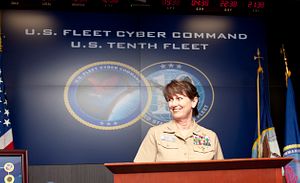A strategy announced last week will improve the ability of the U.S. Navy’s Fleet Cyber Command to fight in cyberspace, envisioning the network as a “war-fighting platform” and toughening defensive units to prevent intrusions.
It’s another step toward an offensive posture on the cyber front, a push that began when Defense Secretary Ashton Carter unveiled a new strategy for the digital age at Stanford University last month. “Adversaries should know that our preference for deterrence and defensive posture don’t diminish our willingness to use cyber options if necessary,” Carter said. “And when we do take action — defensive or otherwise, conventionally or in cyberspace — we operate under rules of engagement that comply with international and domestic law.”
The cyber strategy will see the 10th fleet play a major role. The 10th fleet, originally established in 1943 to supervise Allied anti-submarine training in the run up to the Battle of the Atlantic, was reactivated in 2010 at U.S. Cyber Command in Fort Meade, Maryland, also the headquarters of the National Security Agency. It will house 40 cyber mission teams by 2020, providing support to deployed forces.
The strategy focuses on ensuring that the 10th fleet can successfully develop command and control centers in cyberspace. The fleet is tasked with developing resilient networks and efficient data transfer capabilities, reducing opportunities for network intrusion, and deploying layered tiers of sensors and cyber hunters to ensure proper defensive coverage. Improving the Navy’s network architecture and security processes (or, as the strategy calls them, the “intrusion attack surface”) utilizing intelligence, surveillance, and reconnaissance will be another important step toward realizing that goal.
How does this dovetail with the Pentagon’s new strategy? Fleet Cyber Command’s document helps clarify the fleet’s role. Cyber capabilities are diffused through multiple segments of the military, including Cyber Command, Strategic Command (also responsible for the nuclear arsenal), and the intelligence agencies, such as the N.S.A., in addition to hundreds of collaborators in the private sector. The 10th fleet’s strategy also focuses on defending home networks, systems, and information, which could be jeopardized by a devastating offshore attack. Perhaps less exciting to cyber junkies, but equally relevant, is a focus on centralizing and improving budgetary management, which is divided across a number of sections in the NDAA, and developing a cyber workforce, some of which will sit under the direction of Carter’s chief cyber adviser, who is likely to be named later this year.
The strategy comes with the Pentagon increasingly worried about its ability to control the electromagnetic spectrum and defend against jammers and other advanced enemy weapons systems. In an op-ed in Breaking Defense two years ago, Admiral Jonathan Greenert, the Navy’s Operations Chief, expressed frustration with the ease at which enemies and terrorists could utilize jammers, signal detectors, computer processors, and radios to disable U.S. military technology. “The result is an environment we struggle to sense, understand, and use in warfare,” Greenert wrote. Even GPS signals can be easily jammed and denied by relatively low-cost devices.
That’s not a problem unique to the U.S. military. A RAND Corporation report on China’s People’s Liberation Army found that the force faces significant challenges in space and on the electromagnetic spectrum, despite enormous investments by Beijing in those areas. Non-state adversaries can quickly and decisively exploit flaws in technology, using relatively simple devices.
Fleets, which need a wide variety of technological capabilities to function, are highly susceptible to electromagnetic and cyber attacks. In that sense, this strategy, coupled with $400 million in amendments to the National Defense Authorization Act (NDAA) that will make cyber weapons systems more resilient and invest heavily in new technologies, will be critical to get the United States ready for war in cyberspace. We’ll see if that is enough.

































